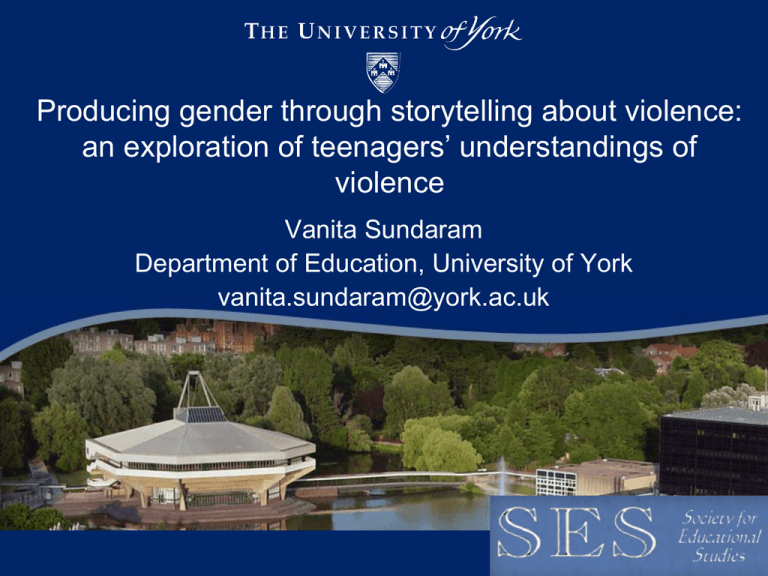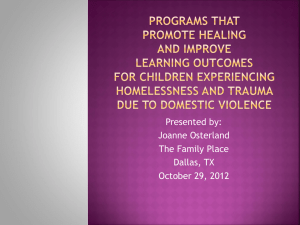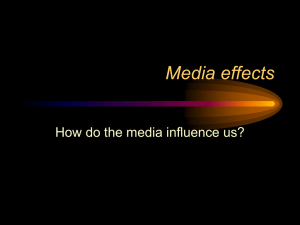
Producing gender through storytelling about violence:
an exploration of teenagers’ understandings of
violence
Vanita Sundaram
Department of Education, University of York
vanita.sundaram@york.ac.uk
Outline of paper
Context – social, political and methodological
Aims and methodology of study
Findings
-
Understandings of ‘violence’
-
Acceptability of violence
-
Deserved and undeserved violence
-
Contradictory discourses
Moving forward: implications for schools and
educators
Context
Increasing prevalence of violence among young people
(13-21 year-olds)
Extreme acts of violence e.g. murder are on the rise, as
intimate partner violence
Violence research indicates that young men are primary
perpetrators of violence in all contexts (macro)
Historically, youth violence research in UK conducted from
criminological perspective e.g. with ‘at-risk’ youth,
homeless youth, offenders
Social class, ethnicity, religion, disaffection have
historically been prioritised over gender in explaining
youth (male) violence
In US context, a similarly ‘gender-neutral’ perspective has
been adopted to analysing youth (male) violence
Context
Recent UK work has explored the role of gender
in relation to young people’s use/understandings
of violence
-
Role of normative masculinity in normalising violence
within intimate relationships (heterosexual) (McCarry,
2010)
-
Construction of women as vulnerable and men as
dangerous impacts on women’s fear of violence
(Hollander, 2001)
-
Role of conservative gender attitudes in acceptance
of violence (Lacasse & Mendelson, 2007)
Context
Zero Tolerance Campaign (1998)
Survey of >2000 young people (14-21 year-olds)
20% of boys/men and 10% of girls/women think
violence is acceptable in some circumstances e.g.
‘nagging’, infidelity
75% of boys/men and over 50% of girls/women thought
the woman was ‘often’ or ‘sometimes’ to blame for
violence
NSPCC (2009)
25% of girls and 20% of boys aged 13-17 have
experienced violence from a partner
Girls more likely to experience violence from partner as
harmful than boys and girls feel less empowered to
reject violence than boys
Context
Less knowledge about why young people accept
and justify the use of violence (McCarry, 2010)
This is Abuse campaign (2009) sought to raise
awareness among young people but resistance to
campaign was apparent
Young people on discussion boards resisted
depiction of intimate partner violence as malefemale; debated definitions of certain acts as
‘violent’; discussed whether some forms of
violence are deserved
Violence prevention/awareness-raising tends to
be premised on expert’s understanding of what
constitutes (interpersonal) violence
Aims
Need to understand how young people
themselves view violence
-
What factors shape/influence these
understandings?
Targeted prevention could seek to challenge
these underlying influences on views of violence
-
Including (especially) gender identities
Increasing recognition of role of schools in
disrupting gender norms, including those which
promote, encourage and justify violence
Aims
“A whole-school approach [is needed to]
tackle attitudes that normalise violence and
abuse by exploring gender stereotypes
[with young people]”
Higgs, 23rd June 2011
Aims
What do young people characterise as violence?
What factors influence young people’s views on
different behaviours as violent (or not)?
Do young people view some forms of violence as
more or less acceptable and/or inevitable than
others?
What are the underlying reasons for differential
perceptions of acceptability?
Specific focus here on how gender is produced
(gender stereotypes and norms) through young
people’s talk about violence
Methodology
-
Regional study comprising 6 schools in Yorkshire
Schools were purposively sampled from sampling frame of
all schools in Yorkshire on the basis of:
Gender composition
Faith
Variations in school ethos
Selectiveness
Small groups (5-6) of Year 10 pupils were randomly
selected in each school
Yielded total sample of ~ 70 pupils
Written consent obtained from parents of all participating
pupils and pupils themselves
Methods
Combination of open-ended questions,
photographs, vignettes, statements about
violence
Each vignette, photograph and statement
depicted mixed-sex encounters
Every vignette and statement was presented with
a female perpetrator and a male perpetrator
Photographs were presented with male-female
and male-male encounters
Materials shuffled ahead of presentation so no
clustering by type of material, gender of
perpetrator or type of violence
Vignette
Based on Prospero (2006) and This is Abuse
campaign
“Steve is playing around with his girlfriend’s phone
and sees that she has received many texts from
another boy in their year.
When Steve asks his girlfriend about this, she says
that she should be allowed to have male friends
and he should stop getting upset about nothing.
Steve pushes his girlfriend and calls her a ‘slut’.”
Statement
Based on Zero Tolerance (1998) answers
Physical
It is acceptable for a woman to hit a man if she
knows he has been cheating on her
Sexual
When a man and a woman are married, it is
acceptable for him to make her have sex with him
Verbal
It is acceptable for a woman to yell at her partner if
he has done something to make her jealous
Photographs
What is violence?
Violence associated with a range of behaviours
-
pushing, shouting, screaming, jealousy, namecalling
-
murder, shooting, kidnapping, rape, child abuse
Girls equally as likely as boys to name
emotional/verbal acts of aggression, and fighting,
use of weapons and sexual assault as violence
Behaviours associated with violence were
stereotypical and similar in comparison with
previous studies of youth violence
Who is violent?
-
Violence associated primarily with young men –
individuals or gangs
Classed assumptions made about violence e.g.
‘chavs’, young men with ‘aggressive dogs’ and
‘young alcoholics’
Some differences in perceptions across schools
in schools with 95%+ minority ethnic pupils,
discussions around stereotypes of certain ethnic
groups as violent
Some recognition that women can be violent and
emotional violence e.g. jealousy, name-calling,
put-downs was frequently associated with women
Acceptability of violence
In vignettes and statements in which the
perpetrator was male the violence was judged to
be ‘unacceptable’ and was identified as ‘wrong’
M: It’s naughty [to hit a woman]
M: He should leave her alone [..] wait until she’s
ready (in response to vignette about sexual
aggression)
M: The man should be the bigger man, he should
just leave it
Where perpetrator was a woman, behaviour was
also defined as ‘violent’ but was seen as more
acceptable
Acceptability of violence
When female was perpetrator, the violence was
viewed as ‘deserved’, ‘understandable’ and as
less serious
M: It was the right thing to do, to slap him
F: I think she has a good reason to slap him
M: He deserves it, well yeah, you can’t go kissing
other girls when you are going out with another
girl
F: It’s like, your immediate reaction, because you’re
so mad at him you just go straight to slap him
Acceptability of violence
The male participants invoked narratives about a
‘feeling’ or ‘sense’ that perpetrating violence
against women was wrong
Yassin: It’s a thing that we know but we can’t put
into words
Particular attention was paid to the perceived
danger of men’s bodies and their ability to cause
harm
Women’s bodies were perceived as less capable
of causing harm – their violence primarily
conceptualised in terms of emotional/verbal
aggression
Deserved and undeserved violence
Perceived acceptability of violence closely
linked to what was considered ‘deserved’ or
‘undeserved’ violence
Assumptions made about context of
violence in vignettes and photographs
- dynamic, relationship between perpetrator
and victim, events leading up to violence
Where violence was narrated as ‘deserved’
it was less likely to be named as violence or
justifications were provided
Deserved and undeserved violence
Violence by a man towards a woman in
vignettes/statements was unanimously
considered to be ‘undeserved’
However, in photographs, stories were produced
to explain, rationalise and justify use of violence
towards men and women
M: She must have done something wrong
F: Maybe they was in an argument…yeah..and
she’d done something wrong
M: He’s been offended [..] you wouldn’t hit someone
just for no reason
Deserved and undeserved violence
-
-
-
-
Justifications of violence (naming of violence as
deserved or not) reflected normative expectations
of gender behaviour
expectations of a woman’s role within
heterosexual relationship
expected punishment for transgression of role
fidelity, chivalry and emotion as gendered
behaviours
men as protectors of daughters and wives
vulnerability and helplessness of women
Deserved and undeserved violence
Some young people did construct stories in which
actions of female victim explained violence against
them (deserved)
Actions of female victim implicitly and explicitly
narrated as going against normative gender
behaviour
F: She’s probably done something to hurt him [like] lied
to him about something
F: He might be asking her to do something again and
again which she does not want to do
F: If she turns him away and he is, like, a violent person
and he feels rejected and embarrassed it could turn
into a violent situation
Contradictory discourses
Contradictions between non-acceptability of all forms
of violence expressed by majority of young people
and internalised knowledge
Male-on-male violence was justified using essentialist
argument about male bodies
- testosterone, male pride and toughness
Men viewed as naturally more inclined to use
violence
M: It’s all in nature, isn’t it like. I mean, throughout the
animal kingdom [..] it’s just, you know, it’s inside us
Contradictions in attitudes towards violence in
photographs as compared with vignettes and
statements
Moving forward: the role of schools
Findings suggest that young people do understand
violence in relatively conventional terms (despite
resistance expressed in previous contexts)
Key role of gender norms and expectations in
shaping young people’s views of violence as
acceptable, deserved or undeserved
If schools are spaces in which gender norms are
produced (Reay, 2001) then schools have an
important role to play in challenging these behaviours
in young people
Anti-violence education must focus on the production
of gender identities and challenge the norms which
are used to explain and even defend violence among
young people
References
Burton, S., Kitzinger, J., with Kelly, L. & Regan, L. (1998). Young
people’s attitudes towards violence, sex and relationships. A
survey and focus group study. Zero Tolerance Charitable Trust.
Barter, C., McCarry, M., Berridge, D., Evans, K. (2009). Partner
exploitation and violence in teenage intimate relationships.
University of Bristol/NSPCC.
Renold, E., & Barter, C. (2003). ‘Hi, I’m Ramon and I run this
place’: challenging the normalisation of peer violence in
children’s homes. In: E. Stanko (ed.), The Meaning of Violence.
London: Routledge.
British Educational Research Association. (2009). BERA Insights
Tender Specification. (http://www.bera.ac.uk/files/2009/03/berainsights-tender.pdf)
Prospero, M. (2006). The Role of Perceptions in Dating Violence
Among Young Adolescents. Journal of Interpersonal Violence,
21(4), 470-484.










